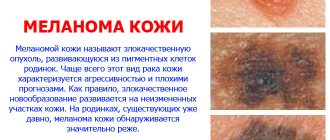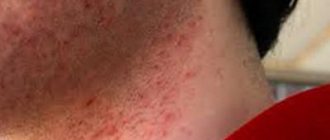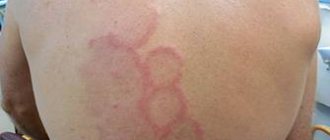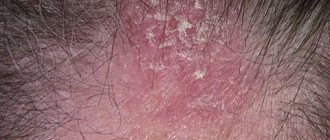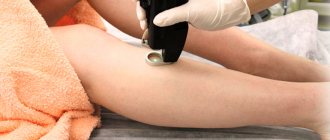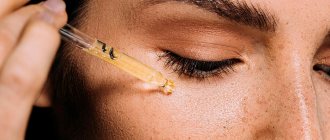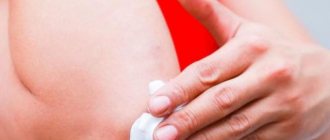Pustular skin diseases (pyoderma) are a group of infectious diseases caused by streptococci and staphylococci. On a healthy body, these microorganisms exist in limited quantities, without manifesting themselves in any way. But with any “entry gate” - skin damage caused by microtraumas, dermatoses with itchy skin, contaminated skin, decreased immunity, chronic ailments, changes in the composition of sweat and increased sweating - they begin to actively develop.
Sometimes pyoderma can be triggered by other infections - Pseudomonas aeruginosa and Escherichia coli, Proteus vulgaris, pneumococci. Pustular skin problems are quite common diseases.
General information
In summer, due to the heat, human skin remains as open as possible and is exposed to a host of irritating factors. Abrasions and scratches on the skin, which are not even visible, are “gateways” for infections; pathogens of pustular diseases, when exposed to favorable conditions, can cause inflammation of the sebaceous glands, skin and soft tissues.
The susceptibility of human skin to pustular diseases is influenced by changes in the chemical composition of sweat and sebum. Wanting to relax at sea, especially in exotic countries, a person finds himself in a completely different habitat, where everything: water, air, food, surrounding microflora is completely new for him, which requires some time for adaptation, that is, restructuring of the immune system, such changes contribute to the spread of both their own microbes and the introduction of “local microflora”.
More often, pyoderma is caused by staphylococci and streptococci. It has been proven that staphylococci are almost always found on the skin of healthy people (most often in the mouths of the hair follicles and in the ducts of the sebaceous glands), however, in only 10% of cases the detected strains are pathogenic - capable of causing disease; in those who are sick or have recovered from a staphylococcal infection, this indicator is sharply increases – up to 90%. Streptococcus occurs in human skin much less frequently - up to 10%, and is localized mainly in the area of skin folds.
Among other reasons that contribute to pustular diseases, there may be increased blood sugar (a breeding ground for microbes), hormonal changes in the body, for example, in adolescence, during pregnancy, if necessary, use hormonal drugs for treatment, decreased immunity in chronic diseases of internal organs .
As a rule, pustular rashes are localized in areas of the skin with increased sebum secretion (forehead, nose, interscapular area, upper chest) and areas with increased trauma - friction against clothing in the armpit area, skin of the inguinal folds.
Why do they appear
The occurrence of purulent acne is caused by the influence of a variety of factors. To establish the exact cause, a comprehensive diagnosis is carried out.
Increased secretion of subcutaneous fat
The cause of the problems is an imbalance of hormones and pathology of internal organs. With increased functioning of the sebaceous glands, pores become clogged, which leads to the appearance of acne.
Hyperkeratosis
The formation of fat entails the active proliferation of bacterial microorganisms. As a result, there is a risk of purulent complications.
Antibiotic abuse
The appearance of purulent rashes is often caused by the use of antibacterial agents. Also caused by steroids, medications containing hormones, and contraceptive medications.
Menstrual cycle and pregnancy
Hormonal fluctuations often provoke the appearance of small subcutaneous acne. The risk category includes pregnant and breastfeeding women. Hormonal imbalances are also observed during menstruation.
Poor hygiene
Insufficient cleansing of the skin from impurities often provokes the appearance of purulent acne. It can also be caused by too frequent washing, which leads to dry dermis. As a result, the sebaceous glands begin to work more actively and acne occurs.
In addition, the use of low-quality cosmetics can cause clogged pores. This is especially true for powder and foundation.
Stress
During psycho-emotional stress, the hormone cortisone enters the bloodstream. This substance leads to increased functioning of the sebaceous glands.
Types
The disease can be caused by different pathogens and affect the skin to different depths. As a rule, pyoderma is caused by streptococcus and staphylococcus. The most common forms of pyoderma:
- sycosis, most often affecting the skin around the mouth;
- folliculitis and ostiofolliculitis, developing anywhere where vellus hair grows;
- boil - purulent inflammation of the hair follicle;
- carbuncle - a purulent-necrotic process in the skin and subcutaneous tissue, often located on the neck and back of the head, on the back, buttocks and thighs;
- hidradenitis, popularly known as “bitch udder” - purulent inflammation of the sweat glands, which often affects obese women;
- Impetigo is a contagious disease that mainly affects children. Manifested by the formation of multiple pustules on the face and body;
- vulgar ecthyma - deep skin lesions on the torso, thighs, buttocks, legs; epidemic pemphigus of newborns, very dangerous for babies in the first weeks of life due to its high contagiousness and severe course.
IMPORTANT! A common symptom is the presence of purulent inflammation, accompanied by pain and often fever, increased temperature, and a general deterioration in health.
With purulent inflammation of the sebaceous glands on the skin of the face, a picture familiar to many young men from the reflection in the mirror appears - acne, leaving behind potholes and scars on the face. A carbuncle can manifest itself as the formation of a large lump covered with reddened, swollen skin. With hidradenitis, an abscess forms in the armpit, causing pain with every movement.
Sycosis
Sycosis is a pustular skin disease caused by Staphylococcus aureus. The development of sycosis is based on neuro-endocrine disorders that change the sensitivity of the follicles.
Since sycosis belongs to the group of pyoderma, its occurrence can be triggered by microtraumas and cuts during shaving. Chronic rhinitis can also provoke sycosis, since the skin above the upper lip loosens, and when blowing the nose, mucus is rubbed in, which contains a large amount of staphylococcal flora. Chronic conjunctivitis often precedes sycosis of the eyelid skin. Removing hair from the nose using tweezers leads to sycosis on the inner surface of the wings of the nose and on the nasal septum.
Although the etiology of the disease is well studied (staphylococcal flora), the pathogenesis of long-term, persistent sycosis is not fully understood. It is assumed that there is a violation of the innervation of the pilosebaceous apparatus, which leads to a change in the composition of the discharge, becoming a good environment for the reproduction and development of pathogenic staphylococci. In addition, a decrease in the body’s immunological resistance is of great importance; neuroendocrine disorders play an important role. The development of sycosis is facilitated by exogenous causes, which include: skin cuts during shaving, maceration (damage) of the skin under the nose with frequent runny nose.
Sycosis is a purulent inflammation of the skin caused by Staphylococcus aureus.
Therapeutic prescriptions are performed by a mycologist or dermatologist. Treatment of sycosis is long-term; the following groups of drugs are used in the process:
- Antibiotics - in the form of syntomycin and gentamicin ointments, in tablets and in the form of intramuscular injections with tetracycline, chlortetracycline, etc. Also penicillin, chlortetracycline hydrochloride (biomycin), oxytetracycline (terramycin) 600,000-800,000 units per day (for 10 days), 5% sulfur-tannin or boron-naphthalan ointment, 10% syntomycin emulsion, aniline dyes
- Lotions with disinfectant solutions (boric acid, potassium permanganate), syntomycin emulsion - in case of exacerbation, to prevent re-contamination with microbial flora and soften the resulting crusts.
- Brilliant green - in the form of a solution is used to treat the affected areas (in the absence of pus), the area around the lesion is lubricated with an iodine solution.
- General strengthening agents, multivitamins.
- Iron supplements (to prevent nervous system disorders).
- Zinc preparations (to improve metabolism).
- Diet therapy (ban on alcohol, sweet, hot, spicy and salty foods).
Laser therapy and UV treatment are indicated. If extensive skin damage is observed, specific immunopreparations are used: staphylococcal antifagin, staphylococcal vaccine (auto- and polyvaccine) and autohemotransfusion (blood transfusion (autohemotherapy)).
Do not wet the affected skin; healthy skin around is wiped with 1% salicylic alcohol. At the same time, chronic rhinitis and inflammation of the paranasal sinuses are treated, and medications are prescribed that normalize the function of the endocrine and nervous systems; Depending on the results of the examination, both male and female sex hormones may be indicated. Shaving is not recommended on affected areas.
Impetigo
Impetigo is an extremely contagious infectious disease that affects the skin, caused by bacteria of the staphylococcus and streptococcus families. Children of preschool and primary school age are most often affected by this disease. Epidemics of impetigo are observed mainly in kindergartens or in individual families. Outbreaks of this disease are subject to thorough investigation to determine the original source of infection, since this disease can be very dangerous due to its complications, especially in childhood.
The causative agent of the disease is beta-hemolytic streptococcus, streptococci, Staphylococcus aureus. Infection occurs when an infection gets on injured skin or at the mouth of a hair follicle. In some cases, the disease occurs as a complication of another disease. Provoking factors for the development of this pathology include: multiple microtraumas on the skin, non-compliance with personal hygiene rules, hypovitaminosis, decreased immunity, anemia, climatic conditions (high humidity).
We also recommend reading: Rash under the eyes of a child
Treatment of uncomplicated forms of impetigo is carried out on an outpatient basis. Therapy has two goals: to eliminate the cause of the pathology and to improve the patient’s overall well-being. Usually, external means are sufficient to stop the process: the lesion is treated with 2% camphor alcohol, the blisters after opening are treated with fucorcin, antibiotic ointments. Vitamin therapy, immunostimulants, and sodium deoxyribonucleate are prescribed in the background. All water treatments are prohibited. The course of treatment is 10 days. If the disease continues to spread, antibiotics are added according to individual regimens: orally or intramuscularly by injection. A diet without sugar-containing products is prescribed, since glucose is a favorable breeding ground for the spread of microbes. Prevention consists of following the rules of personal hygiene and social life. The prognosis is favorable for life. The recovery is complete.
Folliculitis
Folliculitis is an infectious inflammatory process at the site of the hair follicle, which is of fungal, microbial, or viral origin.
Symptoms of the disease
Often pustules form on the scalp. At the beginning of the development of the disease, redness and swelling appear in the area of the follicle; in its central part there is a hair, around which a cone gradually forms containing a purulent mass of yellow-green or white color. When this formation is opened and the pus comes out, an ulcer appears, covered with a crust. The rash is accompanied by pain and itching of the affected area. The process lasts about one week. With deep lesions, after the crust falls off, scars may remain or increased pigmentation may appear. Typically, folliculitis occurs on the face, scalp, groin and armpits, legs and thighs.
Folliculitis is a purulent-inflammatory process in the hair follicle
Causes of the disease
Causes of folliculitis:
- Bacterial infection. This is usually staphylococcus, but can also be pseudomonas or gonorrheal folliculitis
- Fungi of the genus Candida or dermatophytes
- Herpes, herpes zoster, and molluscum contagiosum viruses
- Scabies or demodectic mites
- Minor damage to the skin - scratches, cuts, scratching
- Allergy, dermatitis, itchy skin
- Periodontal disease, caries, gingivitis, chronic forms of pharyngitis or tonsillitis can indirectly contribute to the occurrence of the disease.
The spread of the infectious process is facilitated by the state of immunodeficiency, the use of hormonal ointments, exposure to irritants and household chemicals.
Diagnostics is primarily aimed at determining the nature of the pathogen. Differential diagnosis is also performed to exclude gonorrhea and syphilis. A dermatologist conducts a thorough examination of the patient’s skin, performs dermatoscopy, bacteriological culture of discharged pustules, PCR diagnostics, and RPR test. In some cases, an immunogram, blood sugar test and other examinations are prescribed.
On a note! The choice of treatment methods depends on the causes that caused it and the nature of the pathogen.
To treat fungal folliculitis, the patient is prescribed antifungal drugs; in the case of bacterial folliculitis, local antibiotic therapy is used; in case of herpetic folliculitis, the drug Acyclovir is prescribed.
First, the affected areas of the skin are treated with antiseptic solutions. In order to prevent the spread of the infectious process, the healthy surface of the skin is treated with salicylic or boric alcohol. Ultraviolet light therapy may also be used.
The development of such complications as: abscess, carbuncle, boil, nephritis, lymphadenitis, cosmetic defects in the form of scars is possible.
Carbuncle
A carbuncle is an acute inflammation of several hair follicles with the formation of a purulent-necrotic infiltrate and extensive death of the skin and subcutaneous tissue.
The causative agent of the disease in most cases is staphylococcus. Favorable conditions for infection: increased sebum secretion, sweating, skin contamination. The pathogen penetrates through microtraumas or abrasions on the skin. The appearance of a carbuncle is facilitated by decreased immunity, metabolic disorders (obesity, diabetes), severe illnesses, and exhaustion of the body.
Carbuncle usually occurs on the back of the neck, lower back, buttocks, scapular and interscapular areas, less often on the limbs. A small inflammatory infiltrate appears with a superficial pustule (pustule), which soon increases in size. There is a bursting, tearing pain in the area of the process, a sharp pain when pressed. The skin around the infiltrate is tense, purple in color, and swollen. The epidermis above the source of inflammation breaks through in several places, forming holes from which thick greenish-gray pus is released. Dead tissue is visible in the holes. The holes merge, a skin defect is formed, from which a large amount of pus flows, and necrotic tissue is rejected.
Body temperature rises to 40°C, loss of appetite, insomnia, nausea, vomiting, severe headache, occasionally delirium and loss of consciousness are noted. The carbuncle has a typical appearance and is easily diagnosed upon external examination. If there is a high risk of complications, a culture test for sensitivity to antibiotics may be prescribed. Treatment of carbuncle For local treatment, the skin at the site of inflammation is treated with ethyl alcohol, the hair of the adjacent areas is cut off. The use of ointment according to Vishnevsky gives a good effect. It is also possible to inject the inflammation with antibiotics.
A formed (“ripe”) carbuncle is subject to surgical opening with removal of purulent masses in order to avoid the development of complications, especially if it is localized on the face - due to the risk of infection entering the brain. Self-squeezing of the carbuncle, as well as any warming procedures, is strictly prohibited.
With a carbuncle, purulent inflammation of several hair follicles is observed at once
Furuncle
A boil is a painful, pus-filled lump on the skin. In everyday life, this pathology is called “boil”, “abscess”, “fire”. Men get sick ten times more often than women. Mostly young people are affected; boils are rare in children.
Causes of boils
The formation of boils begins with the contact of bacteria on the skin, most often from the genus Staphylococcus aureus. Many people are asymptomatic carriers of this microorganism. This means that their bacteria live on the skin or mucous membranes of the nasopharynx without causing any harm. When microtraumas (scratches, damage from friction) appear on the skin in combination with other predisposing factors, the microorganism penetrates to the hair root and causes inflammation of the hair follicle along with the sebaceous gland, that is, a fairly deep lesion. The appearance of boils may be one of the first signs:
- diabetes mellitus;
- hematological diseases;
- HIV infections.
Also susceptible to diseases:
- athletes who participate in contact sports or use shared equipment;
- patients receiving immunosuppressive therapy or undergoing chemotherapy;
- people with skin diseases that cause itching and may damage the epidermis (eczema, scabies);
- obese patients;
- people who eat poorly;
- persons who live in close proximity, for example, in military barracks, prisons, homeless shelters.
Furunculosis is said to occur when multiple boils occur. Folliculitis is a separate disease, although it is also classified as pustular skin lesions. In this condition, purulent inflammation does not extend beyond the hair follicle, that is, there is no involvement of either the sebaceous gland or the muscle that lifts the hair.
The hair follicle is closely connected with blood vessels. If you damage them carelessly (for example, by trying to squeeze out pus from an immature boil, where leukocytes have not yet defeated the microbes), bacteria can enter the bloodstream. And this is fraught with blood poisoning. Together with the blood, microbes enter the internal organs, which is why they begin to malfunction.
Boils on the face, neck or scalp are especially dangerous in this regard. The infection quickly enters the brain and can lead to meningitis, cerebral vein thrombosis and other extremely unpleasant conditions.
IMPORTANT! Wash your hands with antibacterial soap before touching the boil and after contact with the boil (whether it is a wound or a purulent head).
Gently apply an antibacterial agent to the affected area 3-4 times a day. Apply a warm compress for 15 minutes 3-4 times a day to relieve pain and speed up the maturation of the purulent head. Then you should cover the boil with a thick layer of gauze and keep the bandage dry.
Under no circumstances should you scratch or pick at the boil, squeeze out or open the boil yourself, because... this can spread the infection. If the boil opens on its own, carefully remove the pus, then thoroughly treat the area with hydrogen peroxide. Then apply a dry bandage. Repeat the procedures every day until complete healing. Take a pain reliever to relieve pain and reduce inflammation.
Do not use over-the-counter medications (creams, wound healing ointments) containing antibiotics without consulting a doctor. Never try to open a boil yourself without your doctor's permission. Wash your hands thoroughly before preparing food, as... Bacteria from the boil can cause food contamination. Diabetics should immediately consult a doctor if a boil occurs.
Your doctor may open the boil by making a small incision with a surgical blade so that the pus can drain, drain the pus, and apply a dry dressing. If necessary, prescribe suitable antibiotics (including ointments). If you have frequent boils (furunculosis), order tests (including to make sure that you do not have diabetes).
In children
Local immunity, like general immunity, develops gradually as a person grows older. Due to the instability of the protective system, the skin of babies is more susceptible to various infectious diseases, for example, pyoderma. It is often diagnosed in children under 4-5 years of age, but also occurs at a later age.
The described pathology combines various bacterial skin lesions. Features of pyoderma in children include several variants of the course of the disease. Infection can occur against the background of existing local or systemic problems (secondary), and with a completely healthy epidermis after exposure to adverse factors (primary). Pyoderma in children occurs due to the activation and proliferation of pyogenic microorganisms. The causative agents of the pathology are mainly staphylococci and streptococci.
Purulent skin diseases are common in childhood
Pustular skin lesions are more often observed in infants, especially in the first months of life. Pyoderma in newborns develops against the background of low activity of local immunity. Their epidermis is thin and sensitive, has an alkaline reaction, not an acidic one, which is a favorable environment for the growth of bacteria. The skin is not yet adapted to temperature changes, changes in humidity, and the work of the sweat glands is not regulated. The listed factors contribute to the activation of pathogenic microorganisms.
Pyoderma in children also occurs for the following reasons:
- avitaminosis;
- unbalanced diet;
- diseases of the digestive system;
- presence of diaper rash;
- open wounds, scratches on the skin;
- failure to comply with hygiene standards;
- stress;
- allergic reactions;
- metabolic disorders;
- physical overload;
- damage to the central nervous system;
- intoxication;
- neurocirculatory dysfunction;
- diabetes.
Mechanism of development of skin diseases
There are external (exogenous) and internal (endogenous) causes that influence the activity of pyococci and the occurrence of pyodermatitis. The first group includes:
- Skin injuries of various types (cuts, irritations, mosquito bites, scratching).
- Maceration (overmoistening) of the skin due to increased sweating or the constant presence of moisture on the stratum corneum.
- Skin contamination: at the domestic level (ignoring hygiene standards) or professional (constant irritation of the skin with fuels and lubricants, coal dust particles, etc.).
- General or local overheating or cooling.
Internal factors:
- Chronic infections (pathologies of the genitourinary system, consequences of untreated caries, ENT diseases).
- Endocrine problems associated with diabetes mellitus, hyperandrogenism, hypercortisolism.
- Chronic alcohol or drug poisoning.
- Unbalanced diet (protein deficiency, vitamin deficiency).
- Immune disorders provoked by the use of glucocorticoid drugs and immunosuppressants in HIV and after radiation.
Both of these reasons reduce all types of immunity and skin capabilities. Gradually the composition of the microflora deteriorates.
Diagnostics
At the first suspicion of pyoderma, be it streptococcal impetigo, or slit-like impetigo (jam), in particular the appearance of a boil on the child’s skin, etc., it is important to seek advice from a pediatric dermatologist. Self-medication can be dangerous. I would also like to note that elements of a pustular rash, such as crusts, should absolutely not be torn off. Pustular manifestations on the skin should not be wetted.
It is not recommended to squeeze out furunculous elements on your own, especially on the skin in the face and groin area. It is important to understand that pustular skin diseases are not always limited to the use of only one antibacterial ointment. Treatment of pyoderma is a complex process, often with the prescription of not only systemic antibiotics, and subsequently the prescription of vitamins, etc.
Physiotherapeutic treatment is often indicated, as well as compliance with dietary recommendations, in particular on limiting sweets, spicy, and fatty foods in the diet. I would like to note that at the present stage of medicine, the prognosis for treatment of pustular diseases is quite favorable.
A dermatologist deals with the problems of pyoderma, but if, God forbid, surgical intervention is required, then a surgeon will do it. It is not enough to just cure the skin; you must understand the causes of the pustular disease.
In all of the above conditions, it is imperative to test your blood for sugar. On increased sugar, microorganisms grow and develop successfully. Particular attention should be paid to pyoderma if acne appears after puberty.
In addition to the above analysis, a fluorogram of the lungs is required, if it is not done, to exclude skin tuberculosis, a stool test for intestinal dysbiosis and an examination of the entire gastrointestinal tract. As for the female sex, an examination of the condition of the uterus and appendages (ultrasound) is also necessary. Very often, inflammation of the ovaries and a shift in hormonal levels in favor of male sex hormones leads to the formation of both acne and folliculitis. It is very typical for this condition to have a rash in the chin area.
There is a misconception that there is no need to consult a doctor again if the patient is a teenager, arguing that “he will grow up or start having a regular sex life and everything will be fine.” This ends with complications in the form of the spread of infection or cosmetic defects.
Deep streptoderma
Erysipelas is an infectious disease most often caused by streptococcus. It occurs both independently and against the background of other inflammatory processes on the skin. Erysipelas is expressed as the appearance of a red spot on the surface of the dermis and implies inflammation of all its layers. The surface of the source of infection is hot, there is a burning sensation, the edges are uneven, and sometimes there is throbbing pain. Symptoms of erysipelas manifest themselves acutely, the patient may feel dizziness, general weakness, and fever. Temperatures can rise to 40 degrees.
Erysipelas can be divided into three forms:
Erythematous erysipelas. It is characterized by uneven edges in the form of tongues, swelling of adjacent tissues.
Bullous erysipelas. A more serious course of this form is due to the detachment of the dermis and the appearance of blisters with escudate. After the blisters dry out, ulcers may appear in their place.
Bullous-hemorrhagic, in which the deep layers of the epidermis are affected and capillary ruptures are possible, followed by bleeding and bloody escudate blisters.
Treatment of erysipelas is carried out taking into account the form of the disease and the general condition of the patient. Sulfonamide drugs are used, and antibiotics for the bullous form are used to drain blisters.
Ecthyma vulgaris is a deep form of streptoderma and is expressed in the occurrence of streptococcal ulcers, which are located on the surface of the lower leg, thighs, and lower back. The initial stage of ecthyma is manifested by the appearance of painful nodes in the deep layers of the epidermis, which gradually turn into pustules followed by tissue necrosis. The lesion increases over time, expanding its edges and deepening. An ulcer appears with characteristic brownish crusts from dried pustules.
Treatment of ecthyma is carried out locally by applying compresses, removing the crust and healing the ulcer. Use syntomycin, tetracycline, erythramecin ointments. In particularly advanced cases, antibiotics are used.
Deep streptoderma is characterized by special consequences for the general condition of the body, as well as the rapid development of the disease itself, for this reason self-medication is unacceptable.
Treatment
A dermatologist treats pyoderma. In case of pyoderma, the hair in and around the site of infection is cut off, but not shaved, in order to prevent the contamination of healthy skin areas with pathogenic microflora; if pyoderma is generalized, then water procedures, including washing, are prohibited. Contact with water is extremely undesirable, especially in the acute phase of the disease.
The skin around the affected area is treated with alcohol solutions of aniline dyes and disinfectants; salicylic acid and a solution of potassium permanganate have a good effect. Despite the fact that contact with water is prohibited, you should thoroughly wash your hands every day and treat your nails with a 2% iodine solution to prevent the spread of infection, and also wipe healthy skin with a damp sponge.
Pyoderma is treated with antibiotics
Nutrition during the treatment period should be balanced, it is better to switch to a dairy-vegetable diet, completely exclude extractive substances and alcohol from the menu, limit the consumption of salt and simple carbohydrates. If the patient is weakened, has concomitant diseases, or pyoderma takes on a protracted or chronic course, when symptoms of intoxication occur, it is advisable to treat pyoderma with antibacterial drugs.
Before prescribing an antibiotic, a bacterial culture of the discharge or scraping is carried out, the pathogen and its sensitivity to the drugs are determined. Penicillin antibiotics are practically not prescribed due to their low effectiveness; macrolides and tetracyclines provide a good therapeutic effect, but erythromycin and tetracycline are undesirable for the treatment of children and pregnant women.
Treatment with combined antibacterial drugs and cephalosporins (cefotaxime, etc.) is prescribed for infection with mixed microflora, since these drugs have a wide spectrum of action and are resistant to bacterial variability. The course and dosage of drugs are prescribed individually, based on the severity of pyoderma; usually, taking antibiotics should not be less than a week. Sulfonamide drugs are less effective for pyoderma, but if the patient is intolerant to antibiotics, then sulfamethoxazole + trimethoprim, sulfomonomethoxine are prescribed in the required dosages.
Active specific immunotherapy in combination with antibiotic therapy and local treatment gives good results, especially in chronic and sluggish processes. Subcutaneous administration of toxoids, specific antigens, and staphyloprotectins twice a week is carried out in a clinic or in a hospital if the patient is undergoing hospital treatment.
To stimulate nonspecific immunity, they resort to autohemotransfusion, transfusion of blood components, ultraviolet irradiation of blood (UFOI); drugs such as methyluracil, Schisandra tincture and Eleutherococcus extract also stimulate the immune system. If there are immune disorders, then it is advisable to treat pyoderma with the administration of immunostimulants from the thymus group of drugs; gamma globulin preparations and stimulators of interferon production. Vitamin therapy is indicated for all types of pyoderma.
Prevention
The following helps prevent the development of pyoderma:
- compliance with hygiene rules;
- timely treatment of chronic diseases;
- compliance with sanitary standards when working in enterprises;
- emergency treatment of wounds and other skin injuries with antiseptics;
- regular preventive medical examinations.
Often, mild to moderate pyoderma is treated at home. But in no case should you ignore the symptoms of the disease - if they appear, you must definitely seek help from a dermatologist. Only a doctor can prescribe adequate treatment and prescribe the necessary dosages of medications.
At home, the patient will only need to observe the rules of personal hygiene, follow the doctor’s instructions regarding pharmacotherapy and promptly treat any damage that occurs on the surface of the skin.
Timely detection of the disease makes it possible to urgently begin treatment. This, in turn, will help avoid adverse complications.
- Strict adherence to all doctor’s recommendations, especially in terms of diagnosis and treatment, makes the prognosis for recovery very favorable.
- Self-medication or an attempt to squeeze out ulcers leads to the spread of infection and aggravation of the disease. This approach causes serious complications that make the prognosis for recovery very unfavorable.
Photo: Before and after
Look, the composition of the active anti-acne cream is pure line. Why is squeezing pimples on the face dangerous? Find out further.
How to treat watery pimples on the penis? The answer is here.
Purulent acne is a fairly serious problem that can significantly worsen a person’s appearance and lead to dangerous complications. To avoid this, it is necessary to consult a doctor in a timely manner and conduct a comprehensive examination of the body.
Consequences
Lack of treatment and deep damage to the lower layers of the dermis by the infectious process can lead to:
- inflammation of blood vessels and lymph nodes;
- spread of infection in the tissue of internal organs and bones;
- purulent abscesses of various localizations;
- purulent mediastinitis;
- development of orbital phlegmon;
- meningitis;
- the formation of blood clots in the vessels of the brain;
- sepsis with serious consequences.
So, pustular diseases are a group of infectious inflammatory skin diseases (Pyoderma). As follows from the word “infectious,” it becomes clear that pyoderma is caused by microorganisms, most often staphylococci and streptococci. On healthy skin, these bacteria can exist without causing any illness. But under certain conditions, such as: various microtraumas and with them dermatoses, accompanied by itchy skin (scabies, eczema), skin contamination, decreased immunity, chronic diseases, changes in the composition of sweat and an increase in its separation (oily skin), manifest themselves.


